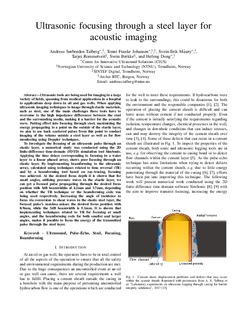| dc.description.abstract | Ultrasonic tools are being used for imaging in a large variety of fields, spanning from medical applications in a hospital to applications deep down in oil and gas wells. When applying ultrasonic imaging techniques to image through elastic materials, such as steel, one of the main challenges these tools have to overcome is the high impedance differences between the steel and the surrounding media, making it a barrier for the acoustic wave. Putting effort into focusing through steel, maximizing the energy propagating to a point on the outside of the elastic layer, we aim to use back scattered pulses from this point to conduct imaging of the volume outside a steel layer as well as for flow monitoring using Doppler techniques. To investigate the focusing of an ultrasonic beam through an Ultrasonic tools are being used for imaging in a large variety of fields, spanning from medical applications in a hospital to applications deep down in oil and gas wells. When applying ultrasonic imaging techniques to image through elastic materials, such as steel, one of the main challenges these tools have to overcome is the high impedance differences between the steel and the surrounding media, making it a barrier for the acoustic wave. Putting effort into focusing through steel, maximizing the energy propagating to a point on the outside of the elastic layer, we aim to use back scattered pulses from this point to conduct imaging of the volume outside a steel layer as well as for flow monitoring using Doppler techniques. To investigate the focusing of an ultrasonic pulse through an elastic layer, a numerical study was conducted using the 2D finite-difference time-domain (FDTD) simulation tool SimSonic. Applying the time delays corresponding to focusing in a water layer to a linear phased array, shows poor focusing through an elastic layer. By implementing beamforming to the ultrasonic array, calculated using techniques related to time reversal (TR) and by a beamforming tool based on ray-tracing, focusing was achieved. At the desired focus depth it is shown that for small angles, utilizing pressure waves in the elastic layer, we can get a focused pulse propagating through the desired focus position with 3dB beamwidths of 4.2mm and 3.7mm, depending on whether the TR technique or the beamforming code was being used respectively. Increasing the angle of incidence to focus via conversion to shear waves in the elastic steel layer, the focused pulse’s maxima misses the desired focus position with 0.9mm, while the 3dB beamwidth is 5.1mm. It is shown that implementing techniques related to TR for focusing at small angles, and the beamforming code for both smaller and larger angles, makes it possible to focus the energy of the transmitted pulse through the steel layer. At the desired focus depth, 20mm below the steel plate, it is shown that for small angles, utilizing pressure waves in the elastic layer, we can get a focused beam propagating through the desired focus position with -3dB beamwidths of 4.2mm and 3.7mm, depending on whether the TR technique or the beamforming code was being used respectively. Increasing the angle of incidence to focus via conversion to share waves in the elastic steel layer, using the beamforming code to calculate the time delays, gives a focused beam propagating through the plate. The maxima misses the desired focus position with 0.9mm, while the -3dB beamwidth is 5.1mm. It is shown that implementing techniques related to TR for focusing at small angles, and the beamforming code for both smaller and larger angles, makes it possible to focus | nb_NO |
| dc.description.localcode | © 2018 IEEE. Personal use of this material is permitted. Permission from IEEE must be obtained for all other uses, in any current or future media, including reprinting/republishing this material for advertising or promotional purposes, creating new collective works, for resale or redistribution to servers or lists, or reuse of any copyrighted component of this work in other works. | nb_NO |
